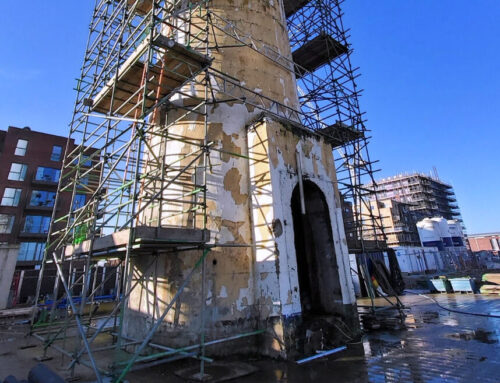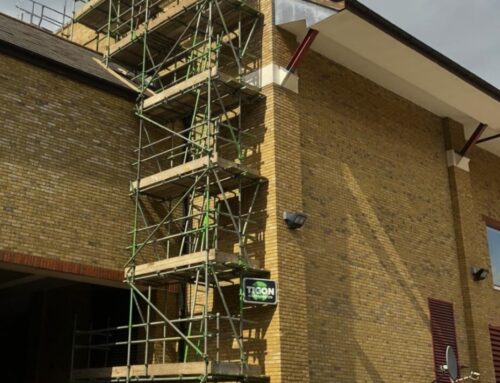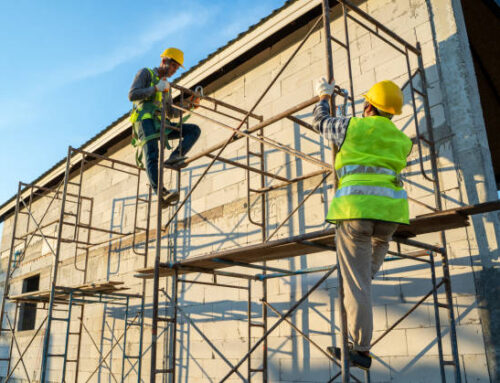When moving forward with home renovation or construction projects, one of the key considerations often overlooked until the last moment is residential scaffold hire. Scaffolding isn’t just a facilitator for large-scale commercial projects; it’s an integral part of many residential improvements, repairs, and extensions. Whether you’re painting the exterior of your home, repairing roof tiles, or adding an extension, scaffolding provides the necessary safety and accessibility for workers and materials.
The decision to hire scaffolding shouldn’t be taken lightly. It requires careful thought and planning to ensure that the project proceeds smoothly, safely, and within budget. This blog aims to shed light on the essential aspects of private scaffold hire, offering homeowners a guide to navigating their options, understanding the complexities involved, and making informed decisions. From safety standards to cost considerations, we’ll explore the top five things every homeowner should know before hiring scaffolding for their residential project.
Stay tuned as we delve into the intricacies of private scaffold hire, ensuring you’re well-equipped with the knowledge to make the best decisions for your home renovation or construction project.
Understanding Your Needs of Residential Scaffold Hire
Before diving into the process of private scaffold hire, it’s crucial to have a clear understanding of your project’s specific requirements. This initial step will not only help in selecting the appropriate scaffolding but also in ensuring that your project runs smoothly and efficiently. Let’s break down the essential aspects to consider.
1.1: Assessing the Scope of Your Project
The scope of your residential project plays a pivotal role in determining the type of scaffolding you’ll need. A simple task such as painting the exterior of a two-storey house might require basic scaffold towers, while more complex renovations or constructions might need modular scaffolding that can be adapted to various shapes and heights. Consider factors such as the height of the work, the need for mobility (will you need to move the scaffold around?), and the weight of the materials and workers the scaffold must support. It’s worth consulting with a scaffold hire professional who can recommend the best type and configuration of scaffolding based on the specifics of your project.
1.2: Duration and Timing
The length of time you’ll need the scaffolding is another critical factor that will influence your private scaffold hire. Scaffold hire companies typically offer various rental periods, and understanding how long your project is expected to take can help you negotiate the best terms. Keep in mind that weather conditions and unforeseen delays can affect your timeline, so it’s wise to factor in some buffer time when arranging your hire period.
Furthermore, the timing of your project could affect availability and pricing. During peak construction months, demand for scaffolding can surge, potentially leading to higher costs or limited availability. Planning your project during off-peak times, if possible, could result in cost savings and more options to choose from.
Understanding these two critical aspects of your project—its scope and its timeline—lays the foundation for a successful residential scaffold hire. With this knowledge, you’re better positioned to discuss your needs with hire companies, ensuring you receive the most suitable scaffolding solution for your project.
Safety First
In any construction or renovation project, safety must be the top priority, and this is especially true for private scaffold hire. Scaffolding increases the efficiency and accessibility of projects but also introduces risks that must be managed through strict adherence to safety standards and regulations. Understanding these safety aspects is crucial for homeowners.
2.1: Safety Regulations and Standards in the UK
The UK has comprehensive guidelines and regulations in place to ensure the safe use of scaffolding. The Health and Safety Executive (HSE) sets out these regulations, which include requirements for scaffold design, erection, alteration, and dismantling to be carried out only by competent and trained individuals. Before hiring a scaffolding service, ensure they are well-versed and compliant with HSE guidelines. This includes conducting risk assessments and ensuring that the scaffold is inspected regularly by qualified personnel, both before it is used and subsequently at seven-day intervals until it is removed. It is vital for homeowners to hire companies that not only understand these regulations but also follow them meticulously to protect all parties involved.
2.2: Choosing a Company with a Strong Safety Record
When selecting a residential scaffold hire company, investigate their safety record and policies. A reputable company should have no hesitation in providing evidence of their compliance with safety standards, including certifications, training records for their staff, and case studies or references from previous projects. Additionally, ensure they have a robust procedure for dealing with emergencies and accidents, including adequate insurance coverage to protect against liability and injury claims.
Choosing a scaffolding company with a strong commitment to safety can significantly reduce the risk of accidents and injuries on your project site. Not only does this protect you and your property, but it also ensures the well-being of the workers and the general public. A safe project is a successful project, and prioritising safety in your private scaffold hire decision is a step in the right direction toward ensuring that success.
Cost Considerations
Cost is a significant factor when it comes to residential scaffold hire. Understanding the financial aspects involved can help you budget effectively for your project. This section will delve into how scaffolding services are priced and what homeowners can do to manage their expenses without compromising on safety or efficiency.
3.1: Understanding Pricing Structures
Scaffolding hire costs can vary widely based on several factors, including the type of scaffolding needed, the duration of the hire, and the complexity of the installation. Basic scaffold towers for a short-term, straightforward project will naturally be less expensive than a large, complex setup requiring multiple platforms and access points. Additionally, the location of your project can affect pricing; projects in urban areas might incur higher costs due to logistical challenges and parking restrictions. When obtaining quotes, ensure they are comprehensive and include all potential costs, such as delivery, setup, dismantling, and hire for the required duration. This transparency will help you compare options effectively and avoid surprises.
3.2: Hidden Costs and How to Avoid Them
Awareness of potential hidden costs is crucial in budgeting accurately for your residential scaffold hire. These can include fees for extending the hire period beyond the initial agreement, charges for damage or loss of equipment, and costs associated with delays in project completion (e.g., waiting for other trades to finish their work). To avoid these unexpected expenses, it’s advisable to plan your project timeline carefully, allowing some flexibility for unforeseen delays. Additionally, discussing these scenarios upfront with the scaffold hire company can clarify your responsibilities and how any additional charges would be handled.
Efficiently managing the costs associated with residential scaffold hire requires thorough research and planning. By understanding the pricing structures and being aware of potential hidden costs, homeowners can make informed decisions that align with their project needs and budget constraints. Ensuring clear communication and agreement with your chosen scaffold hire company will help mitigate financial surprises, allowing for a smoother, more predictable project execution.
The Hiring Process
Navigating the residential scaffold hire process can be straightforward when you know what steps to take. From researching potential hire companies to understanding the contract, this section covers the essentials to ensure a smooth hiring experience.
4.1: Research and Selection
Start by conducting thorough research on scaffold hire companies that specialise in residential projects. Look for companies with positive reviews, strong safety records, and a portfolio of similar projects. It’s also beneficial to seek recommendations from friends, family, or professionals within the construction industry. Once you have a shortlist, reach out for quotes and assess each company’s responsiveness, professionalism, and willingness to address your specific needs. This initial interaction can give you valuable insight into the level of service you can expect.
When selecting a company, consider not only the cost but also their safety protocols, insurance coverage, and the quality of their equipment. It’s worth investing in a company that prioritises safety and reliability, even if it means paying a bit more.
4.2: Contracts and Agreements
Understanding the contract is a critical aspect of the residential scaffold hire process. Ensure that all terms, conditions, and costs are clearly outlined and that you’re aware of your responsibilities as well as those of the hiring company. This includes details on the delivery, setup, maintenance, and dismantling of the scaffolding, as well as any penalties for contract violations or extensions.
Before signing the contract, clarify any points that are unclear and negotiate terms if necessary. It’s essential to have a comprehensive agreement that protects your interests and ensures a clear understanding between you and the hiring company. This step minimises the risk of disputes and ensures that the project proceeds smoothly, with all parties aligned on expectations and responsibilities.
Taking the time to carefully research and select the right scaffold hire company, followed by a thorough review and understanding of the contract, lays a solid foundation for a successful private scaffold hire. This approach ensures that your project is supported by a professional, safe, and efficient scaffolding setup, tailored to your specific needs.
Preparation and Project Management
Finalising your residential scaffold hire is just the beginning. Adequate preparation and effective project management are crucial to ensure that the scaffolding installation and the overall project run smoothly. This section focuses on how homeowners can prepare their site for scaffolding and manage the project effectively.
5.1: Preparing Your Site for Scaffold Installation
Before the scaffolding arrives, there are several steps you should take to prepare your site. This preparation ensures the safety of workers and the efficiency of the installation process. Firstly, clear the area around your home of any obstacles that could hinder access or pose risks to the scaffolding structure. This includes vehicles, garden furniture, and loose garden materials. Additionally, inform your neighbours about the upcoming work, especially if the scaffolding will encroach on their property or affect their access.
Securing any necessary permits is also an essential step. Depending on your locality, you may need permission to erect scaffolding, especially if it will affect public pathways or extend beyond your property line. Starting this process early can prevent delays.
5.2: Effective Communication with Your Scaffold Hire Company
Effective communication with your residential scaffold hire company throughout the project is vital. Ensure you have a clear point of contact within the company for any queries or issues that arise. Regular updates from your scaffold provider regarding installation, inspection, and dismantling schedules will help you manage the project timeline more effectively.
Discuss any potential changes to the project scope or timeline as soon as they arise. Adjustments may affect the scaffolding needs and could incur additional costs or require contract amendments. Transparent communication can help manage these changes smoothly, avoiding misunderstandings and disputes.
By taking proactive steps to prepare your site and maintain open lines of communication with your residential scaffold hire company, you can significantly enhance the efficiency and safety of your project. These practices not only facilitate a smoother workflow but also contribute to the successful and satisfactory completion of your renovation or construction project.
Conclusion
Navigating the private scaffold hire process requires careful consideration of various factors to ensure the success and safety of your home renovation or construction project. By understanding your needs, prioritising safety, managing costs, following a structured hiring process, and preparing effectively, you can achieve a seamless and efficient project execution.
If you’re planning a home improvement project and require residential scaffold hire, look no further than Tigon Scaffolding. Our commitment to safety, reliability, and competitive pricing makes us the ideal partner for your scaffolding needs. Contact us today to discuss how we can support your project and ensure its success from start to finish.
Read more!














